The tea leaf is an amazing thing- it is the realization of so many different factors, coming together to create a beautiful sensory experience in a cup of tea. First, there is the environment and effects of terroir: how clean is a growing region? How much rainfall did the tea receive? What season was it picked in? Everything from elevation and soil composition to that season’s temperature and nearby local flora will ultimately effect the final brew in your tea cup. Consider on top of that the craftsmanship and knowledge of the tea farmers and tea masters who picked and finished your tea: how was the tea picked? How carefully was it processed? Was it picked at just the right time of day?
These are just a few of the variables upon which a good cup of tea depends. The world’s finest teas are grown and picked with a profound level of care and respect for the environment. It requires a rare alignment of all the perfect conditions, and the dedication of everyone involved in the growing and finishing process to share something truly incredible. It also requires the generosity of the farmers to even sell those rare and perfect crops rather than keeping those gems for close friends and family.
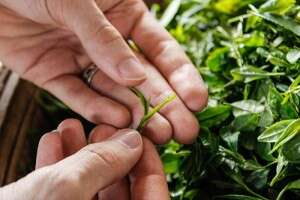
Even still, a good cup of tea is dependent upon the care with which it is brewed. The quality of your water, the time spent steeping – even the light, humidity and weather outside have an effect on the taste of tea! The humbling beauty of the perfect cup is fleeting, enjoyed in the moment and never fully reproduced.
Half Full or Half Empty?
Tasting is Always Subjective
Yet, if meeting all these conditions guaranteed a beautiful cup, things would be much easier than they are. Truly, the most important factor that goes into the taste of a tea is the one never mentioned in the brewing manuals: the temperament and spirit in which the tea is tasted.
Everyone has probably experienced this vividly. If a person is in a bad mood, or sick, they are not going to get as much joy out of a beautiful gift or a moving experience. Someone who has decided that they hate classical music is not going to enjoy a concert no matter the quality of performance, the beauty of the venue or the genius of the composition.
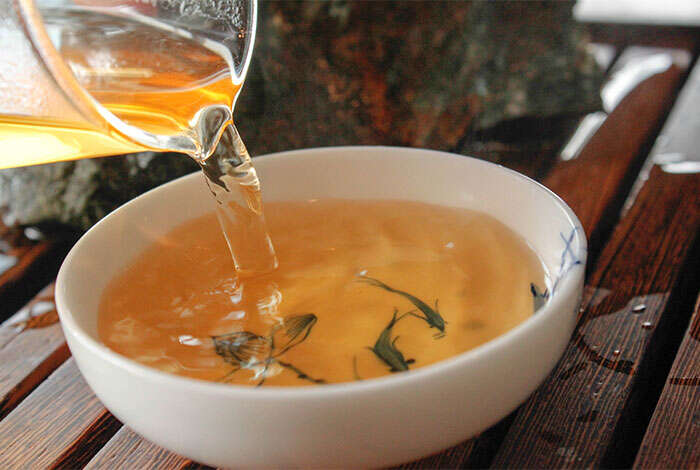
Tea is just as dependent on the mental state of the taster. If you can put yourself in the right frame of mind, quiet the chatter of the everyday, and immerse yourself in the sensory experience of brewing and tasting a cup of tea, every cup of tea can be beautiful. This is the essence and heart of the whole culture of tea in China. All the beautiful objects, the teapots, the ritual, the fine teas – they are only there to make it easier to get to this particular state of mind.
How to Taste Tea – Ritual & Mental Preparation
So, how do you taste tea then? The “easy answer” is simply to learn through drinking lots and lots of tea with guidance from devoted tea friends. Just getting started? Never fear – it is possible to learn proper tasting technique with a bit of ritual to help enforce the state of mind.

Find a time every day to brew tea when you don’t need tea.
If you are looking to taste tea with care, you don’t want to be drinking it for your caffeine kick, to quench your thirst or for any purpose other than enjoying the experience. Removing necessity from the ritual of tea is the first step towards enjoyment. The Chinese ceremony is called gongfu tea – “free time tea.” This is because drinking tea for leisure is so different than drinking tea to accomplish a goal (like hydration or caffeine) or as an accompaniment to work.
Avoid all other distractions and just focus on the tea
There is an important distinction between tea made while working on other things – driving, watching TV, reading, etc – and tea made simply for the pleasure of enjoying that cup of tea. There is nothing wrong with enjoying tea at work, or while busy with other activities. Indeed, tea in these situations can act as a stabilizing force, helping you to stay both relaxed and focused. It also provides a feeling of treating yourself to something special. However, to make a point of truly tasting tea, it is necessary to isolate yourself from other distractions, and give the tea a chance to really show off.
Create a Space for Tasting Tea
Once you have found a time to devote to drinking tea, preferably daily for the benefit of repeating the ritual, you need to find a place to drink it. If you have tea wares, set them all out on a table, or even the floor. If possible, drink tea in a clean room to avoid distraction. Find a comfortable place to sit that you can stay for at least an hour without interruption. Quiet music can be a good tool to stay relaxed, though silence is also perfectly acceptable, as it allows you to appreciate the sounds of the tea ritual, the rumbling boil of a kettle, the pouring of water, the clinking of porcelain or yixing clay.
Take a few moments to appreciate your tea
and remember its source.
Bring out the tea you plan to brew. Place the dry leaves on a saucer so that you and your guests can look and smell. Pick up the leaves, feel the down on the buds, the smoothness of a flat-pressed green, the texture of a brick of pu’er Look at the colors, try to imagine the plant itself and the forest or farm where the tea could have been picked. Even if you have not seen the farm yourself, try to give each tea you drink a location, a home, a story. Even if you do not know the farmer who picked the tea, imagine a farmer putting their craft into the leaf. I suggest this seemingly frivolous step because anything removed from a context is easy to objectify. Placing a tea in context makes it familiar and worth respecting.

Brew with care and intent
This article is not a discussion of ideal brewing, as that will change for every tea, so brewing is treated elsewhere on the site. While brewing your tea, try to focus on the motion of your arms as you pour water, the gesture of your hands as you hold the tea pot. As an exercise, try pouring as gracefully as you can. The physical care that you put into preparing the tea will help clear your mind of other thoughts, and give you more investment in the tea brewed. I always enjoy tea that I brew with intent and care more than tea brewed casually.
Also be sure that while brewing, or after the first rinse or infusion, you take the lid off of your teapot or gaiwan and smell the wet leaf. The intense aroma of the wet leaf is a great preview that will get your taste buds primed for what lies ahead. Seeing the leaves dancing in the water in the case of green and white teas is also a great visual treat. Taste may seem like the primary sense involved in tea, but ultimately tasting tea requires an appreciation of sound, touch, visual beauty and smell. All feed into each other, and a positive experience with one sense will influence your other senses.
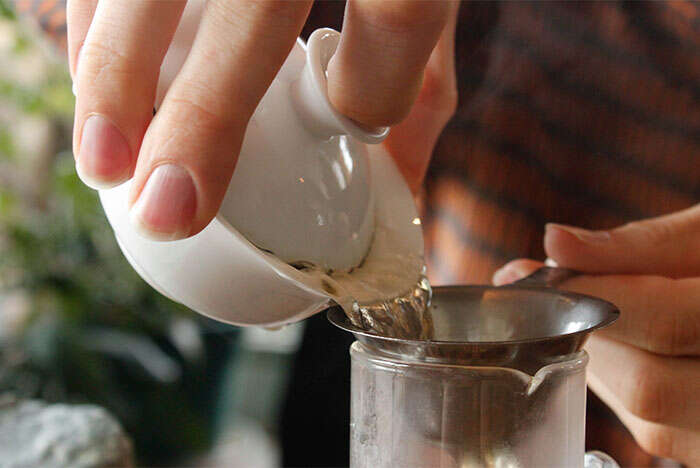
Sip with care
Finally, you are ready to take the first sip. Be sure to use small cups whenever possible to really appreciate the tea, and to allow yourself to go through many infusions of the same leaf. Take a slow sip, let the tea liquor linger in your mouth. Swish it over the tip and sides of your tongue, noticing the texture and weight of the tea in addition to the flavor. Finally, swallow the tea slowly, and then exhale gently, noticing the flavors and sensations on the tongue in the exhale. Wait at least a few seconds before taking a second sip to give the aftertaste time to emerge.
Taste, Texture & Aroma
On your first sip, don’t try to place the flavor, or describe it. Just enjoy the full sensation. Wait until the second or third sip to begin contemplating the flavors. I always find it a useful exercise to reach for similar identifiable tastes related to the tea. Common elements of a flavor palate include several spectrums of taste:
First, there is the vegetal spectrum, which can be divided out into sharper taste, like fresh cut grass, but can also be more mild and leafy like spinach, or savory like asparagus. Grassy elements of flavor are most common in green teas, but can be present in oolong, white tea, pu’er and even some black teas.
Next, there is the fruity spectrum. This includes crisp fruity tastes like apple, but can be juicy like peach, citrusy like orange or distinctly sweet like banana. Oolongs are often characterized as fruity.
The darker side of the fruit spectrum is the berry flavor grouping. The tart side of this is like hibiscus, but darker more mild berry flavors can be described as black berry or even elderberry. Big Red Robe is a good example of the dark berry profile.
Berry moves gracefully into spice, like cinnamon, ginger, and peppercorn. Spice can slide into savory elements like saffron, raw cacao, semolina, or malt. Black teas are often malty and sometimes spicy.
These flavor guidelines are only mentioned to give you a few ideas of words you can use to help think about and appreciate what you are tasting. Try to create your own personal flavor spectrum based on foods or tastes you identify with. The fun begins when a tea is not simply a single flavor, but an intriguing and unexpected combination of flavors.

Flavor is only the beginning of what fine tea has to offer. Hopefully by this point you are having a blast tasting the subtleties of tea in a way that is personally meaningful. (Everyone tastes tea differently). Now it is time to start thinking about texture and mouthfeel. As you sip tea, swish it back and forth and try to “feel” the tea on your tongue in addition to tasting it. Some teas have a weight that makes them seem creamy. Others are light, and almost feel slightly carbonated like they are sparkling. For textures, you may find that you have to evoke weird images to understand the tea. I often think of things like old books, leather, linen, stone, and wood when contemplating a texture.
Once you get an idea of the texture, you can stop and think about the aftertaste. Fine tea leaves a wonderful taste in the mouth that grows over time. Some last hours. The aftertaste that grows in your mouth will actually act in harmony with later steepings of the tea, strengthening the flavors that you are tasting.
Taste Fine Tea in Fine Company
Throughout the whole process, it is often useful to discuss what you are experiencing with friends. I always find that my tea tastes better in good company. I may be tasting some elements of the flavor, while my friend is tasting something completely different. We share our experiences, and use them to listen more closely to the tea and taste a greater depth of flavor and texture.
Ultimately, when you finish the tea, you have the whole experience to reflect on. We often like to draw conclusions of whether or not we enjoyed a tea. We want to rate something and place it in order of best to worst. While it is tempting to do so, try to refrain from thinking about the tea as a product to judge. Instead think about your whole experience, and reflect on the beauty you were able to appreciate. Recall your favorite element of the tea, write it down so that you remember what you were most interested in while drinking the tea.
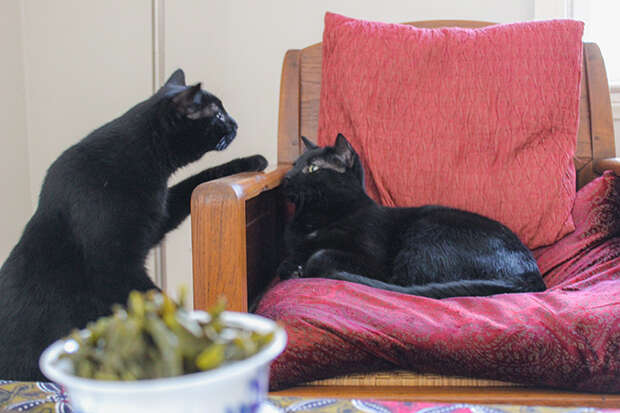
Enjoy!
I am confident that by following a few basic suggestions, you can vastly enhance your tasting experience. Don’t think of tasting as an objective skill to learn. If somebody tells you that you should taste apple in a tea, but you taste orange, just enjoy the orange. Tea, and all the ritual around it, exists to help you appreciate beauty to a greater degree in your everyday life, and to act as an antidote to those things that distract us from beauty. Once you see this, you will discover the way every tea offers a glimpse of true beauty: a reflection of the land where it grew, of the care of its tea farmers, and of your own mindset in tasting
Drink slowly, and most of all, have fun!


 How To
How To Myths & Legends
Myths & Legends Travelogue
Travelogue Tasting Journal
Tasting Journal Talking Shop
Talking Shop Tea 101
Tea 101 Watch
Watch Teaware
Teaware News
News
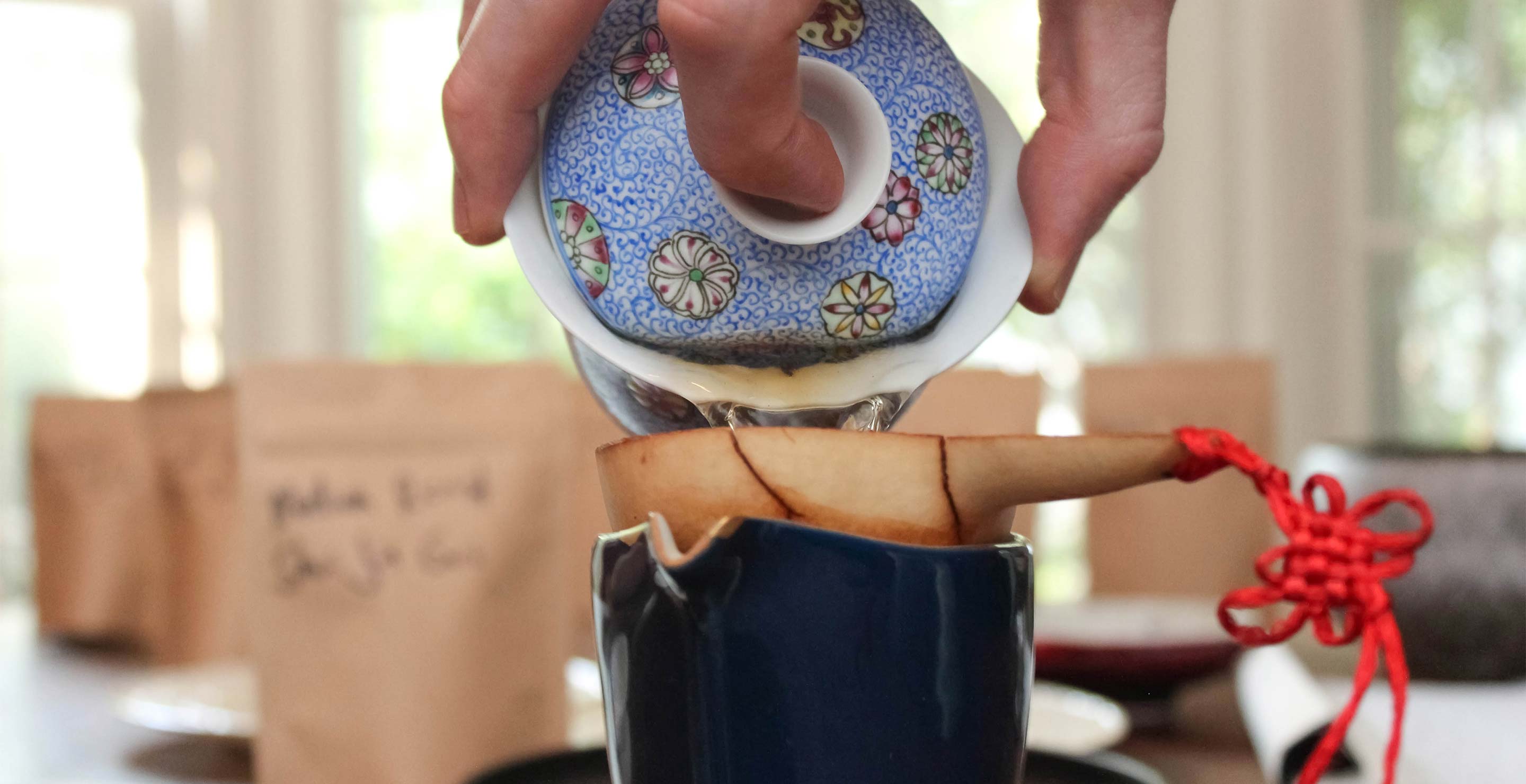

Leave a Reply
thank you again for writing this David!
this definitely helped me to categorize different flavors and tasting aspects more then i have... i am going to re read this article before i brew up some Tung Ting formosa later!
Great article! Some interesting points that I haven't considered include the effects of light/weather have on tea. This makes sense, however I have not thought about it. I would really like to try the tips included here: drinking tea with no distractions, clean room, stay there for 1 hour, ect Now I need to find the time! !!
Thanks Dan, I hope that you can find the time and place. It truly does make a difference. Happy tasting.
Excellent article David!
I wish I had read this back when I worked at the tea house. You make tea tasting so accessible. :)
Aww, thanks. Great to hear from you. I hope that you are doing well, and that tea is still a prominent part of your life. Best wishes,
David
While I began reading this article expecting a discussion of how to prepare *the tea*, I was pleasantly surprised by a discussion on how to prepare *yourself* to enjoy it! I'll be keeping this in mind. Thanks!
Well put. Even I forget this aspect of tea drinking sometimes, and it always affects the brewed cup.
I love this article! I like how you don't see tea tasting as an objective thing. I was scared to try higher quality teas because I wasn't sure if I would be able to appreciate them as they deserve to be appreciated, but after reading this I am much more eager! Thank you!
Thank you so much! Definitely don't be scared to try higher quality teas. The best teas go pretty far in demanding attention and laying out their complexities to be tasted. All you have to do is listen. It is a high compliment to know that this article may make you more eager to explore fine teas.
Thank you, this is a really helpful article!
I really like how you made of point of how important the atmosphere is when drinking tea. I feel like this is the part that I skip most often.
The way you write about tasting tea somehow makes me feel as if I was actually tasting it! Haha...such a relaxing exercise. I should consciously practice it more often!
"You take a cup … you have some water in your thermos…. you take some tea, you put the tea in the water. Drink it. That’s tea culture. You don’t need to know anything else."
very helpful, thanks for writing! i've never really considered the importance of the experience itself.